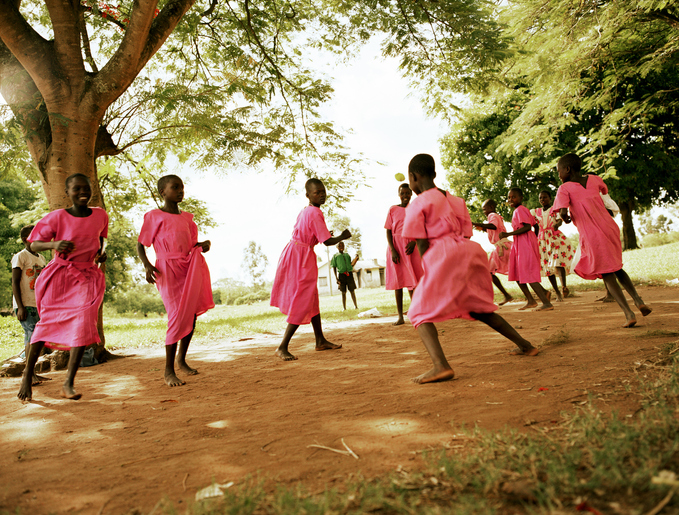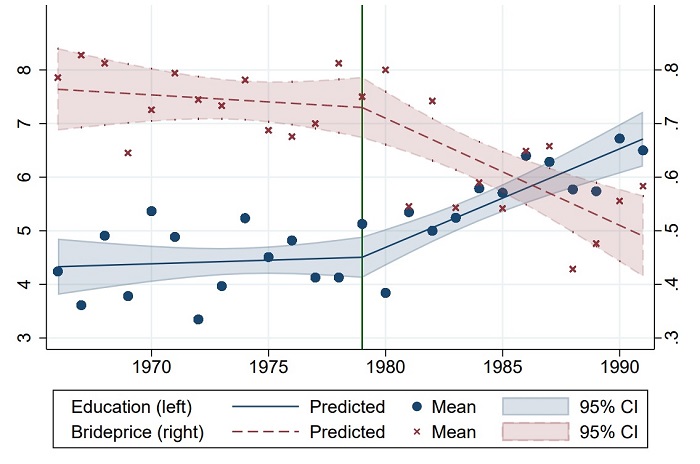IDE Research Columns
Column
Uganda Abolished Primary School Fees and Improved Educational Attainments. Did the Reform Affect Brideprice, Too?

Masaru NAGASHIMA
Institute of Developing Economies, JETRO
September 2023
Uganda implemented Universal Primary Education (UPE) in 1997, which eliminated primary school fees. Studies have found that the reform has improved education outcomes, particularly for girls, those in rural areas, and those from poor households. This study extends the existing findings by demonstrating that the reform also affected the brideprice practice. Our survey data reveal that longer UPE exposure is associated with a smaller likelihood of having a brideprice agreed upon at marriage. We conjecture that UPE increased female education and enhanced their economic opportunities, leading to greater bargaining power and reduced brideprice payment. The reduction can improve women’s welfare in Uganda, where brideprice is supposed to be returned to men upon divorce, thus making it difficult for women to choose marital dissolution even when their relationship turns sour.
Brideprice Payment in Sub-Saharan Africa
Marriage is a special occasion in many traditions. In some, marriage can formally establish the relationship between otherwise ununited families; it can hold a large ceremony, inviting relatives and neighbours; it can also involve transfers, both in cash and in kind, which can sometimes be substantial. In our study site, Uganda, brideprice is the most common marital wealth transfer sent from the groom to the bride’s parents. Our survey respondents told us that for a marriage to be formally recognised in the community, brideprice is indispensable. It is also believed that brideprice embodies the groom’s gratitude and appreciation to the bride’s parents for raising her.
The environment surrounding brideprice has changed recently. Anderson (2007) stated the practice used to be prevalent in many places―not only in Sub-Saharan Africa but also in Europe and Asia―hundreds or thousands of years ago but has since waned over time. She synthesised anthropological contributions, pointing to modernisation as the potential cause of the decline, and highlighted the importance of further research to understand what aspects of modernisation have facilitated the change in cultural practice. She also stressed the role that economics can play in elucidating the mechanism behind the change.
Uganda’s Primary Education Reform
One of the issues facing the country was low levels of education. ORC Macro (2004) reported that one-third of children of primary school age were out of school, and only one-third of the population 15 years or older completed primary school in 1995. One major impediment was households’ financial constraints, including school fees and contributions to parent–teacher associations (Nishimura, Yamano, and Sasaoka 2008).
After being elected in May 1996, President Museveni announced the Universal Primary Education (UPE) policy, which eliminated primary school fees in December 1996 and implemented the drastic reform in January 1997. Despite limited facilities, classroom congestion, and other issues, the reform dramatically escalated enrolment rates. Studies have discovered its greater impact for girls than boys, children from poor households than wealthy households, and those in rural areas than those in urban areas (Deininger 2003; Nishimura, Yamano, and Sasaoka 2008; Keats 2018).
UPE and Brideprice Practice
In Uganda, brideprice is supposed to be refunded upon divorce and can thus make it difficult for wives and their natal families to choose to divorce even when they want to. This suggests that marriage without brideprice can broaden the choices of wives and their natal families. As the UPE reform disproportionately improved female education and equipped women with more economic opportunities, it might also have strengthened their bargaining power relative to their husbands and eventually increased marriages without a brideprice payment.
Economic theories can provide other possible hypotheses for the relationship between female education and the brideprice practice. A notable conjecture is that when parents expect the change mentioned earlier in the bargaining power in their children’s marriage, they may change their investment in their children’s education. This can make their children marry a different partner, and the brideprice payment decision may also differ. Furthermore, polygyny―a type of marriage where a man marries more than one wife―can distort the marital match by leaving some men unmatched and forcing them to either pay a brideprice to find a partner or give up marrying. The recent decline in polygynous marriages can alleviate the pressure on young unmarried men to pay a brideprice.
Increased Female Education and Decreased Brideprice Practice
We collected data about marital payment during the Research on Poverty, Environment, Agriculture, and Technology survey in 2015. The survey covered 1,755 households from 117 villages in Uganda. We targeted women aged 24 to 49 and asked detailed questions about marriage, such as premarital residence, whether their marriage was based on love or arrangement, and, of course, the presence of brideprice payment.
Using the data collected, we find that UPE is associated with an increase in female education and a decrease in marrying with a brideprice payment. These findings are visually summarised in Figure 1. In our data, the 1979 cohort was the first cohort exposed to the UPE reform. Older cohorts born before 1979 exhibit stable trends of completed education at around 4.5 years and marriage with a brideprice payment at approximately 75%. On the contrary, younger exposed cohorts born in 1979 and after had an evident change in these trends such that completed education gradually increased and marriage with a brideprice payment decreased. Our data reveal that it took ten years for all the female children to benefit from free primary education, suggesting that the expansion of the UPE coverage was ten percentage points (ppts) every year. Our data indicate that a 10-ppt increase in the UPE coverage was associated with approximately 0.2 more years of completed education and 2 to 3 ppts fewer marriages with a brideprice payment.

Figure 1. Years of Education and the Brideprice Practice in Uganda.
Note: This figure plots the years of education (left axis) and the share of women (right axis) who had a brideprice payment agreed upon at their first marriage for each birth cohort and their kinked linear fits.
Source: Author based on the study by Nagashima and Yamauchi (2023).
We then explored the mechanism behind the decline in marriages with a brideprice payment. We find that our data are consistent with the bargaining power hypothesis. On the other hand, we do not find empirical support for other mechanisms. For example, marital partners of women with UPE exposure appear to have much the same educational attainments as those of women with no UPE exposure (i.e., we find little evidence of a significant change in what economists call marital sorting—a tendency that people with similar traits are more likely to marry than those with dissimilar traits). Moreover, we find no noticeable change induced by UPE in the steadily diminishing trend in the share of women in polygynous unions.
Implications
UPE is likely to have made it easier for Ugandan women to overcome one of their barriers to divorce by increasing their economic opportunities. This implication complements the existing evidence on the impact of UPE on various outcomes, such as female education and women’s reproduction. Our results also contribute to the economic literature on brideprice. In particular, our study opens up a new question on the ultimate impact of the decline in the brideprice practice on women’s welfare in the long run, which calls for further research.
Author's Note
This column is based on Nagashima, Masaru and Chikako Yamauchi. 2023. “Female Education and Brideprice: Evidence from Primary Education Reform in Uganda.” World Bank Economic Review. https://doi.org/10.1093/wber/lhad020
References
Anderson, Siwan. 2007. “The Economics of Dowry and Brideprice.” Journal of Economic Perspectives 21 (4): 151–74.
Deininger, Klaus. 2003. “Does Cost of Schooling Affect Enrollment by the Poor? Universal Primary Education in Uganda.” Economics of Education Review 22 (3): 291–305. https://doi.org/10.1016/S0272-7757(02)00053-5.
Keats, Anthony. 2018. “Women’s Schooling, Fertility, and Child Health Outcomes: Evidence from Uganda’s Free Primary Education Program.” Journal of Development Economics 135 (November): 142–59. https://doi.org/10.1016/j.jdeveco.2018.07.002.
Nagashima, Masaru, and Chikako Yamauchi. 2023. “Female Education and Brideprice: Evidence from Primary Education Reform in Uganda.” World Bank Economic Review. https://doi.org/10.1093/wber/lhad020
Nishimura, Mikiko, Takashi Yamano, and Yuichi Sasaoka. 2008. “Impacts of the Universal Primary Education Policy on Educational Attainment and Private Costs in Rural Uganda.” International Journal of Educational Development 28 (2): 161–75. https://doi.org/10.1016/j.ijedudev.2006.09.017.
ORC Macro. 2004. DHS EdData Education Profile: Uganda. Calverton, MD: ORC Macro.
* The views expressed in the columns are those of the author(s) and do not represent the views of IDE or the institutions with which the authors are affiliated.
** Thumbnail image: Group of girls (6-12) playing, Uganda (David Sacks/ The Image Bank/ Getty Images)

